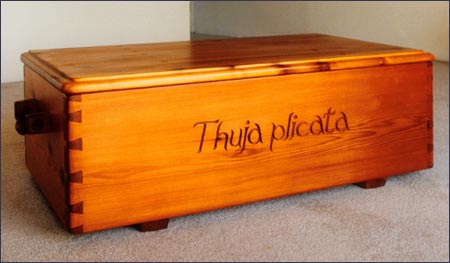Chest - Thuja Plicata

40 in. x 20 in. x 14 in.
Western Red Cedar
This box has two sides and two ends which are made from solid boards. This
forms the main carcase, and the pieces are joined together with simple 'through
dove tail' joints - five tails at each corner.
The lid is constructed from boards joined edge to edge. The hinges
for the lid actually add strength to the joinery used here. The
wooden hinges are made, so that yew wood battens extend across
the underside of the lid. These battens are secured by screws located
in secret pockets, beneath a pattern of round plugs in the top
surface of the lid. The hinges swing on three bronze pins, mounted
in yew wood housings, fixed directly into the rear side of the
box. The hinge battens allow the woodwork in the lid to expand
and contract as conditions demand but they also tend to keep the
lid straight and flat so that any 'cupping' of the boards is minimised.
Each end of the chest is pierced with two rectangular mortises,
to accommodate two short wooden pins made of yew. These pins serve
as bosses for the chest handles. The handles are made of rope covered
with leather stitched neatly in place between the handle bosses.
The front side of the chest is inscribed with the botanical name
for Red Cedar, Thuja Plicata. The Greek
word plicata, bears reference to the appearance of the leaves of
the tree - their folded and
rather plaited arrangement.
The bottom of the box is a single panel made from several boards
of solid cedar glued edge to edge. This panel is mounted in a framework
fixed to the inside of the carcase, so that the panel itself is
free to move as humidity and temperature change.
The chest itself sits above the floor on hardwood skids fixed
directly to the sides of the box.
Return to
the Gallery.
|
